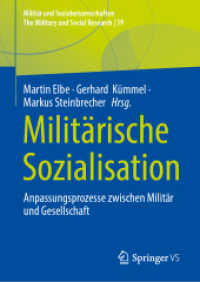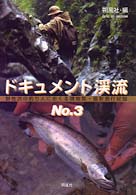- ホーム
- > 洋書
- > 英文書
- > Science / Mathematics
Full Description
For courses in Chemistry Laboratory.
This comprehensive laboratory manual features 29 experiments with a focus on real-world applications. These experiments were written specifically to correspond with the 8th Edition of CHEMISTRY by Robinson/McMurry/Fay. Each experiment explores one or more topics, covered within a chapter in the textbook, with the goal of helping students understand the underlying concepts covered in the lecture course and allowing students to apply what they've learned in lecture to an actual situation where used. Each experiment discusses what it entails along with why it is important and where the concept and/or technique will be applied again. The labs are designed to replicate a typical research-style experience with experiments that are investigative in nature.
Contents
1. A. Measurement and Expression of Experimental Data
B. Graphing and Statistical Analysis
A math review, including practice with significant figures, rounding rules, graphing techniques, and statistical analysis.
2. A Submarine Adventure: Density Saves the Day
The concept of density is explored by measuring the density of a solid and a liquid and by developing a mock submarine.
3. Conservation of Matter
A reaction of copper nitrate and zinc is observed to determine if mass is conserved.
4. Plop, Plop, Fizz, Fizz: The Mass Percent of NaHCO3
The reaction of Alka-Seltzer® tablets with acetic acid is used to determine the mass percent of sodium bicarbonate present in each tablet.
5. Proof of Alcohol
An unknown alcohol solution is analyzed for the mass and volume percent of alcohol by separation methods.
6. Empirical Formula of a Compound
An unknown sample is analyzed for the empirical formula of a metal sample via a crucible and heating.
7. Pancake Mix as a Limiting Reactant
Determining the limiting reactant of two reactants and identifying the percent by mass composition of the original mixture.
8. Redox Reactions in Voltaic Cells: Construction of a Potential Series
Microscale unit cells of several metals are created and their potentials are measured to create a potential series.
9. Reactions in Aqueous Solutions: Strong Acids and Bases
The pH and concentration relationships for the reaction of HCl and NaOH are investigated.
10. The Copper Cycle
Watch copper metal react in various was to transform from a solid to a liquid back to a solid through a series of reactions.
11. Atomic Spectra
Several unknown light sources are identified by use of spectrometry.
12. Colligative Properties of Solutions
Exploring colligative properties by determining 1) the freezing point (Tf) of cyclohexane, 2) its molal freezing point constant (Kf) and 3) the freezing point depression (ΔTf).
13. Building Molecular Models
Lewis structures are presented in model form and investigated.
14. Calorimetry and Hess's Law
The enthalpies of reaction are determined for both magnesium metal and magnesium oxide in water. These enthalpies are then used in conjunction with Hess's Law to determine the enthalpy of reaction for magnesium burning in oxygen.
15. Gas Laws and Air Bags
Ideal gas law and stoichiometry are used to construct a working mock-up of an automobile airbag.
16. Intermolecular Forces and the Triple Point of CO2
Intermolecular forces are investigated by observing the temperature depression created when different solvents evaporate. The triple point of CO2 is observed and measured.
17. The Purification of Water
Fresh water samples are tested for phosphate before and after purification.
18. Kinetics: The Iodine Clock
The iodine clock reaction is measured at room, high, and low temperatures and its rate constant is determined.
19. Photometric Determination of an Equilibrium Constant
The equilibrium constant for the reaction of iron(III) thiocyanate is determined by photometric methods.
20. Analysis of Vitamin C in Fruit Juices by Titration
Titration will allow identify the concentrations of substances in solutions.
21. Murder Solved by the Analysis of a Kiss
Identify which lipstick was present at the crime scene by comparing chromatograms.
22. Entropy, Free Energy, and Chemical Equilibrium
The thermodynamics of the solubility of Ca(OH)2 are determined using titration.
23. Electrochemistry: The Nernst Equation
Unit cells are built from various metals and then tested at several temperatures. The free energy is determined using the Nernst equation.
24. Qualitative Analysis: Anions
Qualitative analysis is used to investigate the chemical properties of 11 anions, and those properties are used to identify the anions in an unknown sample.
25. Qualitative Analysis: Cations
A traditional qualitative analysis scheme is used to determine the group I—V cations in an unknown mixture.
26. Qualitative Analysis: Cations, Anions, and Complex Ions
A single-day, microscale qualitative analysis is used to determine the cations and anions in an unknown mixture.
27. Whodunit? A Forensic Investigation
A murder is investigated by means of several chemical forensic methods.
28. Chemical Structure and Smell
Several organic chemicals are investigated by relating their functional groups and structural similarities to their odors.
29. Proteins, Carbohydrates, and Fats: Analysis of a Peanut
The biochemical composition of a peanut is analyzed by use of acrolein, Fehling, and xanthoproteic chemical tests.
Appendix A: Glossary of Terms Used in This Manual
Appendix B: Excel Tutorial
Appendix C: Volumetric Glassware
Appendix D: Standard Reduction Potentials (in Volts), 25 oC








